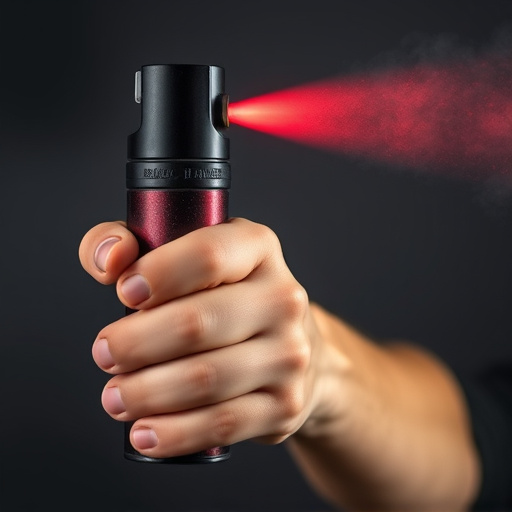Pepper spray's effectiveness relies on its optimal temperature range of -20°C to 49°C (-4°F to 120°F), crucial for maximizing its chemical adherence and incapacitating effects. Temperatures outside this range can lead to degradation, reducing spray intensity or inactivation. Storage within the recommended -4°F to 122°F range preserves effectiveness. Understanding local laws regarding acquisition, use, and storage is vital to avoid legal issues, ensuring responsible handling and safe personal security.
Personal security is a growing concern, with pepper spray emerging as a powerful tool for self-defense. This comprehensive guide explores the inner workings of pepper spray canisters, delving into the active ingredients and their effectiveness against potential threats. We examine the critical factor of the optimal temperature range in pepper spray performance, ensuring users are equipped with vital safety considerations and usage guidelines. Additionally, we discuss legal implications and responsible purchasing options for those seeking protection.
- Understanding Pepper Spray: Active Ingredients and Effectiveness
- The Role of Optimal Temperature Range in Performance
- Safety Considerations and Usage Guidelines
- Legal Implications and Where to Purchase Responsibly
Understanding Pepper Spray: Active Ingredients and Effectiveness
Pepper spray, also known as oleoresin capsicum (OC) spray, is a non-lethal self-defense tool designed to incapacitate an assailant temporarily. Understanding its active ingredients and effectiveness is crucial for users to ensure optimal deployment. The primary active ingredient in pepper spray is capsaicin, a chemical compound derived from chili peppers. Capsaicin irritates the eyes, nose, throat, and skin, leading to temporary blindness, coughing, and difficulty breathing. This reaction disrupts an assailant’s ability to continue attacking, providing the user with valuable time to escape or seek help.
The effectiveness of pepper spray is influenced by several factors, including the optimal temperature range at which it operates best. Most pepper sprays are designed to be effective in a specific temperature bracket, typically between -4°F to 120°F (-20°C to 49°C). Beyond these ranges, the spray’s chemical composition and consistency can change, impacting its ability to adhere to an assailant’s skin and eyes. Knowing and understanding this optimal temperature range ensures that users can rely on their pepper spray as a reliable means of personal security in various environmental conditions.
The Role of Optimal Temperature Range in Performance
The performance of a personal security inflammatory spray, or pepper spray, is significantly influenced by its optimal temperature range. This range ensures that the spray remains effective and potent when deployed in various environmental conditions. If a canister’s temperature falls outside this ideal range, the chemical composition can degrade, leading to reduced spray intensity and potential inactivation.
For optimal effectiveness, pepper spray should be designed to function reliably between -10°C and 40°C (14°F to 104°F). This temperature window allows for consistent activation and distribution of the active ingredients upon discharge. Canisters operating outside this range may struggle to project a strong enough stream or even fail to disperse the spray effectively, leaving users vulnerable in potentially dangerous situations.
Safety Considerations and Usage Guidelines
When considering a personal security inflammatory spray canister, safety should be your top priority. Always inspect the device for any damage or defects before each use, ensuring the safety mechanism is intact and the canister is fully charged. Keep it stored in an optimal temperature range—typically between -20°C and 50°C (4°F to 122°F)—to maintain its effectiveness. Avoid extreme heat or cold as these conditions can compromise the integrity of the spray.
Usage guidelines are crucial for effective and safe application. Aim for the attacker’s face, eyes, and nose, as these areas are most vulnerable. Keep a safe distance of approximately 3-5 feet (1-1.5 meters) to ensure optimal range and avoid accidental self-defense. Never point the spray at anyone you don’t intend to defend yourself against, as it could cause harm or embarrassment. Immediately dispose of the canister responsibly after use, following local regulations for hazardous waste disposal.
Legal Implications and Where to Purchase Responsibly
When considering a personal security inflammatory spray canister, it’s crucial to understand the legal implications surrounding its use and acquisition. The legality of pepper spray varies significantly by region, with specific rules regarding age restrictions, allowed uses, and storage. It’s essential to research local laws to ensure compliance and avoid any potential consequences.
Purchasing a pepper spray canister responsibly involves selecting a reputable supplier that adheres to safety standards. Look for products certified under recognized testing guidelines, ensuring they operate within the optimal temperature range for effective deployment. Reputable sellers will also provide clear instructions on safe handling, storage, and disposal, contributing to responsible use and minimizing legal risks.
Personal security inflammatory spray canisters, or pepper spray, are powerful tools when used responsibly within the legal framework. Understanding the active ingredients, their effectiveness, and safety considerations is crucial for optimal deployment. The optimal temperature range plays a significant role in performance, ensuring reliability when it matters most. Always remember to purchase from reputable sources and adhere to usage guidelines. By doing so, you can confidently navigate potential threats while navigating the legal implications surrounding this game-changing personal security device.
